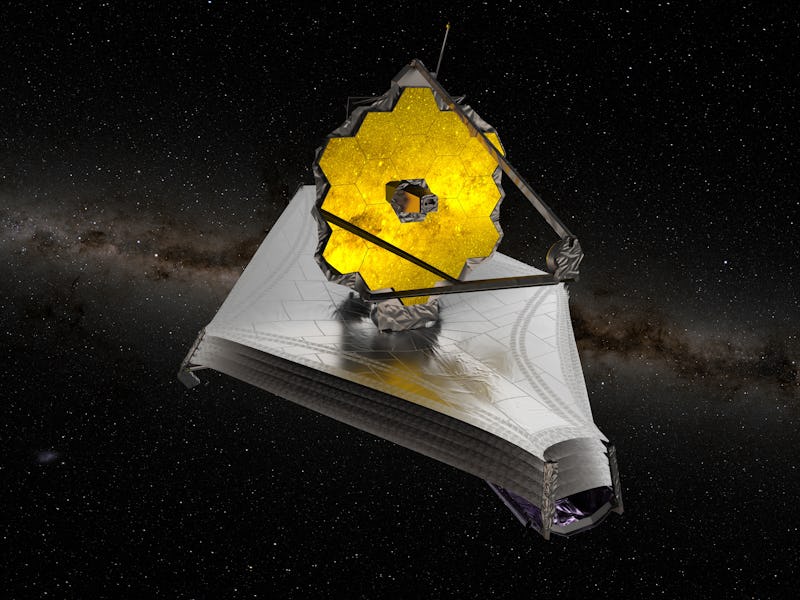A micrometeor just smacked into the Webb Space Telescope — it wasn’t the first
In deep space, no one is coming to Webb’s rescue. And that’s ok.

The best-laid schemes o’ mice and men gang aft agley, as the poet Robert Burns wrote in his 1785 piece “To A Mouse” — and the team behind the James Webb Space Telescope are not immune to this truism.
Despite positioning Webb at a relatively clean area of space called Lagrangian Point 2, some million miles from Earth and the myriad space junk that surrounds us, the telescope has sustained a direct hit. In this case, a micrometeor smacked into one of the telescope’s primary mirror segments, one of the 18 gold and beryllium coated hexagons that will enable us to observe the universe as never before. NASA revealed the damage on Wednesday, June 8 in a news release, although it appears the event actually occurred at some point between May 23 and May 25.
What happened — At some point between Tuesday, May 23 and Thursday, May 25, the James Webb Space Telescope’s primary mirror segment C3 sustained a micrometeor impact. A micrometeor is a dust-sized particle that is whizzing through space so fast as to make it powerful enough to do damage.
In response, the Webb’s engineering team has performed an initial adjustment to the positioning and alignment of the mirror segment, NASA confirmed Wednesday. These adjustments allow teams on the ground to take into account and cancel out any image distortion that may result from damage to the mirrors — although its not a perfect solution.
As Inverse previously reported in January from a Webb-related media briefing, the issue with being a million miles from Earth is that there is no way to send a repair crew — so Webb is stuck with a partially damaged mirror segment:
“Let’s say, a piece of debris hits it,” posits Julie Van Campen, a NASA engineer and a deputy commissioning manager for the James Webb Space Telescope. “And then we had a problem like that broke a mirror,” or another piece of kit, she continues. What protects the telescope from this eventuality happening?
“The answer is not much,” she says. “What you see is what you get.”
The Webb’s mirror segments can be seen in this early selfie.
Why it matters — The Webb’s team always knew that the telescope would get damaged in space. Micrometeors are so tiny as to be near-impossible to track and avoid. What matters however is that the Webb represents a feat of engineering, whereby the telescope has been built to withstand rips, tears, and direct hits for the duration of its science mission in such a way that it will still provide unprecedented views of our cosmos. In fact, as one NASA scientist on the Webb team reveals on the Webb blog, this is actually not the first micrometeor hit.
NASA states on the blog:
After a successful launch, deployment, and telescope alignment, Webb’s beginning-of-life performance is still well above expectations, and the observatory is fully capable of performing the science it was designed to achieve.
Digging into the details — An intriguing detail of the latest impact is that the Webb had no idea this meteor was coming, despite undergoing rigorous impact simulation testing that was designed to help it detect and avoid these kinds of micrometeors. But in a strange twist, this micrometeor was larger than the Webb team had accounted for during the testing phase. NASA states in the blog:
“While the telescope was being built, engineers used a mixture of simulations and actual test impacts on mirror samples to get a clearer idea of how to fortify the observatory for operation in orbit. This most recent impact was larger than was modeled, and beyond what the team could have tested on the ground.”
“Since launch, we have had four smaller measurable micrometeoroid strikes that were consistent with expectations and this one more recently that is larger than our degradation predictions assumed,” states Lee Feinberg, Webb optical telescope element manager at NASA Goddard, in the same post.
“We will use this flight data to update our analysis of performance over time and also develop operational approaches to assure we maximize the imaging performance of Webb to the best extent possible for many years to come.”
The Webb was housed in pristine condition before launch, but it won’t stay that way in space.
What’s next — Most immediately, the Webb’s team will continue adjusting the C3 mirror segment to try and minimize the degradation to the mirror’s optical performance.
“We designed and built Webb with performance margin — optical, thermal, electrical, mechanical — to ensure it can perform its ambitious science mission even after many years in space,” says Paul Geithner, technical deputy project manager at NASA’s Goddard Space Flight Center in Greenbelt, Maryland, in a statement on NASA’s Webb blog.
Despite the damage, the James Webb Space Telescope is due to give the world a jaw-dropping view of our universe on July 12, 2022. This will likely come in the form of four or more images that demonstrate its four instruments’ capabilities, as well as data and other observations that speak to how it will be used during its first year of operation to study exoplanets, galaxies, the first stars, our Solar System, and more.
The impact will have no bearing on that schedule, according to NASA, so stay tuned for the first science images in July. We cannot wait.